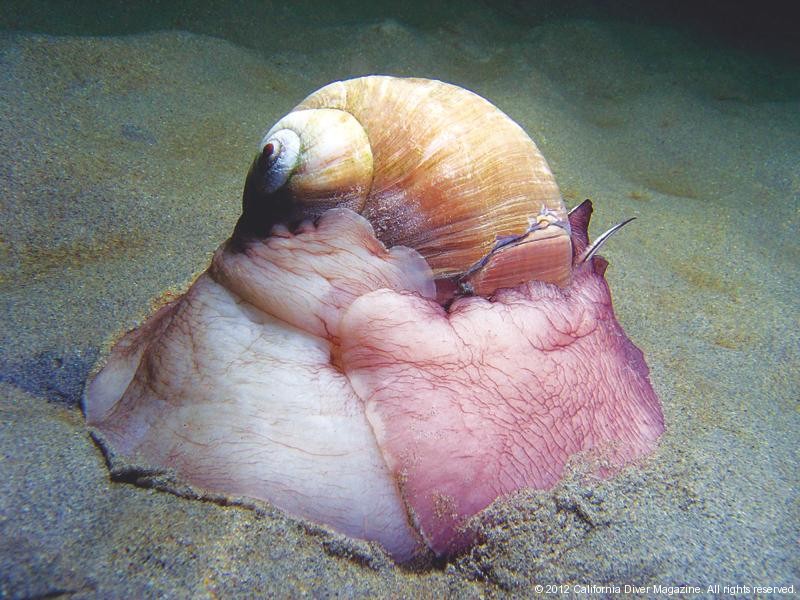What would Escargot be like without a shell? Not the same, that’s for sure. How well would an abalone or moon snail fare without their heavy shell? Not well I am sure.
Text by Dave Behrens, Photos by Kevin Lee
Snails, whether on land or in the ocean have shells for a very good reason – their own protection. Without the shell to retreat into, shelled mollusks are vulnerable to all forms of predation, because they have no other means of defending themselves. But the burden of carrying an impenetrable domicile around all the time has its price. Shelled mollusks are inherently slow moving, making feeding and mate selection, just that – slow, and possibly a chance opportunity. Organisms that are efficient feeders and mates – are usually able to move efficiently. Being able to crawl fast, without the weight of a heavy shell has given sea slugs and opportunity to feed over wider areas and find potential mates more easily, relying less on opportunistic chance.
Evolution works in funny ways, over time some behaviors or anatomical features may disappear from a species, while other new ones may appear. Before the loss of the heavy gastropod shell could be fully accomplished, snails with precursors of new defense strategies had to be selected for. With each subsequent new generation, those individuals having new defensive strategies survive, while those armed to a lesser degree, may not. It’s all about being able to successfully reproduce and pass on your genetic information to the next generation. Given enough time, maybe hundreds of thousands of years, the shell-less sea slugs we know today have replaced the heavy shell with new “high tech” defense systems.
The shell-less species are represented by the dorids, aeolids, dendronotina and arminina nudibranchs, while in the more primitive groups the shell has been retained but is now internal, within the body. Examples of these are members of the Family Pleurobranchidae, sea hares and some cephalaspians, such as the Navanax. In sea slugs that no longer have a shell, this form of protection has been replaced by an array of different armaments and a number of unique survival strategies. Some like Gastropteron have gained the ability to swim away quickly. Others such as sea hares produce clouds of ink to confuse their attackers. Some have become so cryptic that enemies simply cannot see them anymore. But for most “nudibranchs” the need to hide in a shell has been replaced by either a noxious chemical deterrent system, or the use of stinging cells acquired from the slugs own prey.
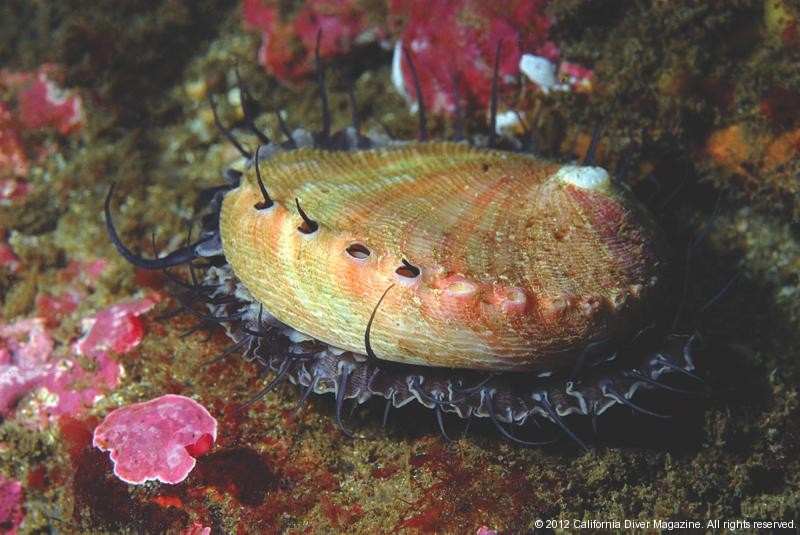
Other large shelled species like abalone cannot flee into their shell, but instead hold tightly to the substrate to avoid being eaten.
It is hard to tell whether many of the species of sea slugs that retain a shell today, are in process of replacing it with another defense system, or in fact are going back to the use of a shell. Many of these groups like the side-gilled slugs, the Pleurobranchs, have both an internal vestigial shell, and a chemical defense system. Which way are they going – to the use of the chemical warfare, or back to the protective shell? And then there is that group of sacoglossids that still retain an external shell, but can autotomize (release) body parts to distract wanton predators. On land we see this strategy used by lizards who can detach their tails, leaving predators confused by the wiggling appendages left behind. Examples of these are Lobiger and Oxynoe. Here again, which direction is their development going? Towards the shell or towards the alternative?
Species like Lobiger and Oxynoe drop segments of their body when perturbed by predators or nosey divers.
And, how about Tylodina? It has a pretty large shell, but is simply invisible on its encrusting prey sponge, Verongia. What’s up with that?
This specimen of Tylodyna has given away its protective advantage by crawling off its host sponge, Verongia, making itself game to any wanton predator.
At the risk of sounding terribly anthropogenic, the most advanced survival strategies in my way of thinking are the use of chemical secretions and the firing of projectiles from the slugs body. This is the stuff Sci-Fi movies are made of.
Dorid nudibranchs are the masters of chemical repugnance. Metabolized from organic chemicals found in the sponges dorids feed on, they include an arsenal of acids, bases and just plain nasty tasting juices. These living chemistry labs transform benign chemicals into potent weapons for their own use. In most species the chemical labs, referred to as mantle glands, line the edge of the animal dorsal surface.
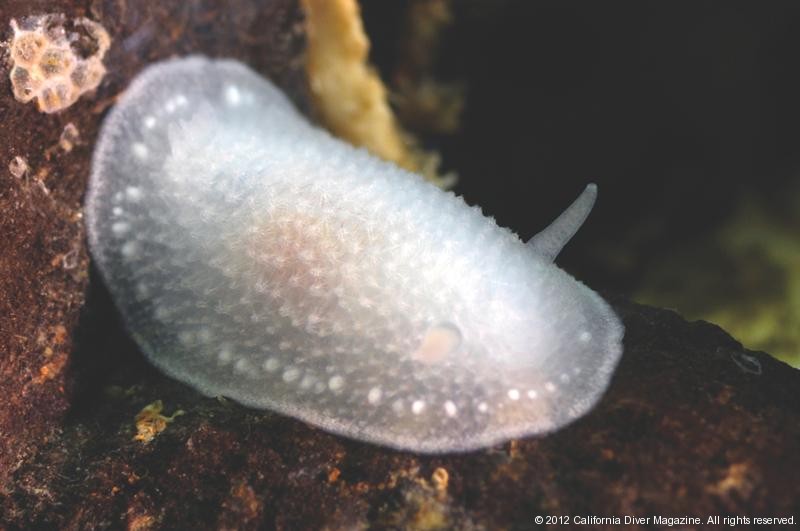
The acid glands in Conualevia alba are easily seen within the mantle tissue of this semi-transparent dorid.
When disturbed, these glands squirt their nasty products at the attacker. This form of chemical warfare is so repugnant and successful that predators remember the foul experience and avoid ever disturbing these guys again.
Many species of dorid nudibranch warn potential predators that they carrying nasty chemicals with bright color patterns. Here are a few examples.
In the projectile defense group we have the aeolid nudibranchs that harbor stinging cells in the tips of their cerata. The stinging cells, properly referred to as nematocycts, originated in the living cnidarian prey, the aeolids feed on – specifically sea anemones, corals, hydroids, jellyfish, and others of this group. Nematocysts are stored in the tips of the cerata in an organ called the cnidosac. When the cnidosacs are touched by a inquiring predator the nematocysts fire, much as they do in their original host.
I am repeatedly asked – Why don’t nudibranchs cause the nematocysts to fire when they eat the coral or hydroid? How come slugs are immune? And, how do they recoil their harpoon like shaft?
The long tapering cerata found on the back of all aeolid nudibranchs not only act as lungs for respiration, but can house an arsenal of microscopic harpoons.
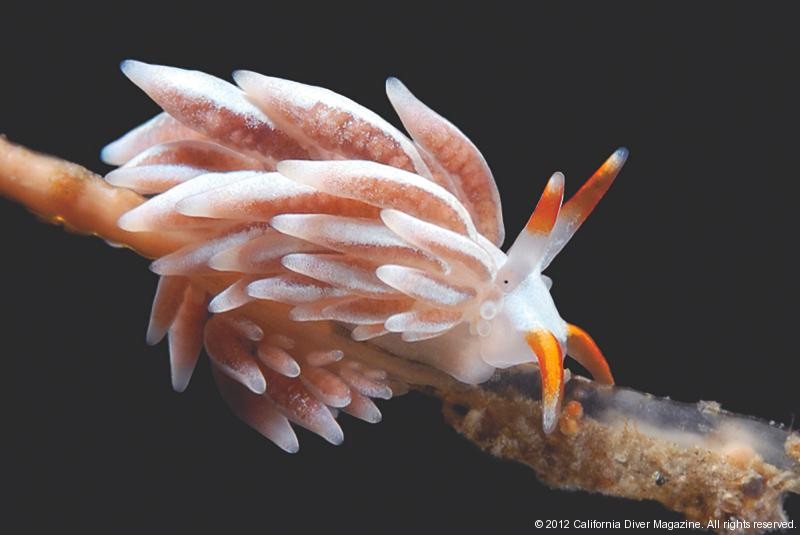
The long tapering cerata found on the back of all aeolid nudibranchs not only act as lungs for respiration, but can house an arsenal of microscopic harpoons.
Actually, nudibranchs are not immune to the cnidarians stinging cells, and do fire them. Once the nematocyst is fired it cannot be recoiled or used again. Interestingly, the stinging cells used by the nudibranchs as artillery defense are immature nematocysts maturing within the hydroid or coral, when it was fed upon. They are too immature to fire and therefore get swallowed by the slug, which then passes them up through their digestive system, into the cerata, where they then complete their maturation into fully operational stinging cells. Keep in mind, hydroids and corals are continuously making millions of new stinging cells, to replace those that have been fired, defending themselves. Nudibranchs must do the same thing – replace discharged stinging cells as they are fired at potential predators, with a continuous supply of immature cells.
Nematocysts can be quite complicated, and varied. While some look and operate like a whaler’s harpoon, others are able to wind around prey, or are sticky, an act like an adhesive rope, holding the prey.
I am amazed by the diverse collection of defense strategies that have been developed by this group of mollusks. While this arsenal of weapons was not developed overnight, the complexity and efficiency of the tactics is truly amazing. The Department of Defense could learn a thing or two from these very adept, successful survivors.
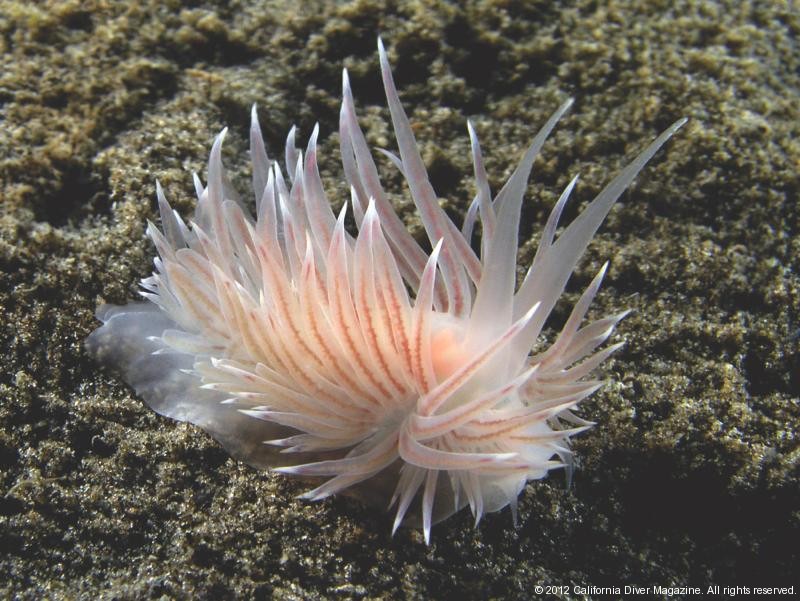
The next time you see Cumanotus feeding on a hydroid, pause and watch it twitch as it gets stung by its own prey nematocysts.
Text by Dave Behrens, Photos by Kevin Lee
All photos and copy ©2012 and may not be reproduced without express permission.
Visit Kevin Lee’s website and view more of his photos at diverkevin.com
.

